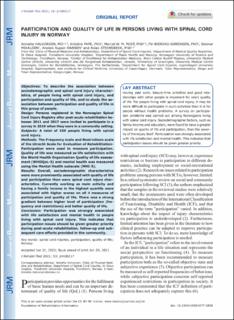| dc.contributor.author | Halvorsen, Annette | |
| dc.contributor.author | Pape, Kristine | |
| dc.contributor.author | Post, Marcel W. M. | |
| dc.contributor.author | Biering-Sørensen, Fin | |
| dc.contributor.author | Mikalsen, Steinar | |
| dc.contributor.author | Nupen Hansen, Anders | |
| dc.contributor.author | Steinsbekk, Aslak | |
| dc.date.accessioned | 2021-10-07T09:01:36Z | |
| dc.date.available | 2021-10-07T09:01:36Z | |
| dc.date.created | 2021-08-05T12:47:38Z | |
| dc.date.issued | 2021 | |
| dc.identifier.issn | 1650-1977 | |
| dc.identifier.uri | https://hdl.handle.net/11250/2788326 | |
| dc.description.abstract | Objectives: To describe the association between sociodemographic and spinal cord injury characteristics, of people living with spinal cord injury, and participation and quality of life, and to study the association between participation and quality of life in this group of people.
Design: Persons registered in the Norwegian Spinal Cord Injury Registry after post-acute rehabilitation between 2011 and 2017 were invited to participate in a survey in 2019 when they were in a community setting.
Subjects: A total of 339 people living with spinal cord injury.
Methods: The Frequency scale and Restrictions scale of the Utrecht Scale for Evaluation of Rehabilitation-Participation were used to measure participation. Quality of life was measured as life satisfaction with the World Health Organization Quality of life assessment (WHOQoL-5) and mental health was measured using the Mental Health subscale (MHI-5).
Results: Overall, sociodemographic characteristics were more prominently associated with quality of life and participation than were spinal cord injury characteristics. Currently working as main activity and having a family income in the highest quartile were associated with higher scores on all 4 measures of participation and quality of life. There was a strong gradient between higher level of participation (frequency and restrictions) and better quality of life.
Conclusion: Participation was strongly associated with life satisfaction and mental health in people living with spinal cord injury. This indicates that participation issues should be given greater priority during post-acute rehabilitation, follow-up and subsequent care efforts provided in the community. | en_US |
| dc.language.iso | eng | en_US |
| dc.publisher | Foundation for Rehabilitation Information | en_US |
| dc.rights | Navngivelse-Ikkekommersiell 4.0 Internasjonal | * |
| dc.rights.uri | http://creativecommons.org/licenses/by-nc/4.0/deed.no | * |
| dc.title | Participation and quality of life in persons living with spinal cord injury in Norway | en_US |
| dc.type | Journal article | en_US |
| dc.type | Peer reviewed | en_US |
| dc.description.version | publishedVersion | en_US |
| dc.source.journal | Journal of Rehabilitation Medicine | en_US |
| dc.identifier.doi | 10.2340/16501977-2858 | |
| dc.identifier.cristin | 1924107 | |
| cristin.ispublished | true | |
| cristin.fulltext | original | |
| cristin.qualitycode | 1 | |

